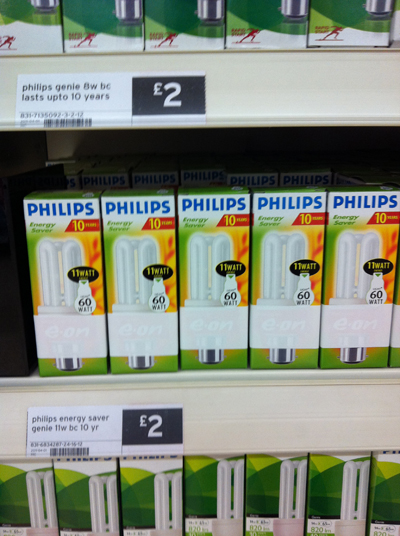
Repriced lamps with “EON” subsidised label covered
As of April 1, 2011 ( This is no joke!) the energy suppliers’ subsidies of CFLi “energy saver” lamps in the UK is ended. As predicted, because there is no “inefficient” option anymore due to the European legislation, there is no argument to maintain this very suspect practice. Recently there have been some really crazy offers, the pound stores have been offering 4 for £1 and even the supermarkets have had similar priced offers. Today it has all changed.
The price for a lamp equal to the 60W Incandescent has been decided between the lamp manufacturers and supermarkets to be £2. This is the new price for a 11W CFLi and “coincidentally” a 42W halogen energy saver costs £1.98 in the same supermarket. It seems that this is the price point that has been decided as there is no way that I can accept that two such different products whose only common factor is the amount of light produced could realistically cost exactly the same, particularly as TH lamps are also available in the Pound store!
So the manufacturers and supermarkets have achieved their aim of getting rid of a low price low profit product , the incandescent lamp, and replacing it with a much higher priced item that, incidentally, is substantially less good.
Kevan Shaw April 2, 2011

So true Kevan…
I cover the price topic here
http://ceolas.net/#cc2130x
point no 4 in the rundown
4. It is sometimes suggested that if everyone has to buy “energy saving” products, more will be made so that each product costs less to make, on economy of scale, and therefore in turn the product will be cheaper to buy.
This might at first seem a good point.
But this is exactly the sort of thinking that keeps leading politicians and officials around the world (as in the EU) to fill the trouser pockets of farmers, house builders, “green tech” businessmen and what-nots in the expectation that they will then be so kind as to provide cheaper agricultural produce, cheaper housing, cheaper “green” energy and energy saving products etc for the people.
Cheap in production does not mean cheap on the market!
For energy saving products:
• the manufacturers charge what they can on the marketplace, regardless of how much they sell:
they can indeed lower the prices and still make a profit, but only the pressure of competition ensures it.
• cheap competition from “energy demanding” products, which keeps down prices overall, has been removed.
• there are fewer manufacturers making the usually more complex products, again reducing competition. This is particularly the case when lobbying local manufacturers with patented green technology succeed in banning the competition (as happens in the EU).
• pre-ban subsidies on “energy saving” products, which keeps down their prices, has likely been removed,
in no longer being seen necessary to shift those products, given that the cheap competition has been removed.
Competition of course not only keeps prices down, but also gives variety of choice for consumers, and one should not ignore product quality, achieved not just through bureacratic standards and inspection, but also through consumer demand:
With sufficient competition, manufacturers get more interested in doing market research, to make products that satisfy consumers.
(>> regarding the above,
saying subsidy “has likely been removed”
read “has been removed”, in light of this post!)